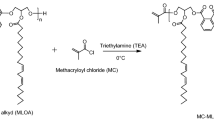Abstract
A dual-cure hydrophilic acrylate polymer was synthesized via radical polymerization with acrylic acid (AA), isophorone diisocyanate (IPDI), 2-acrylamide-2-methylpropane sulfonic acid (AMPS), hydroxyethyl acrylate (HEA), and 3-(trimethoxysilyl)propyl-2-methyl-2-methacrylate (MPS) as monomers, then used as prepolymer for antifog coating with tetraethylorthosilicate (TEOS) as a novel crosslinker. The prepolymer was mixed with crosslinking agent and photoinitiator to form coating formulas. The coating was characterized by nuclear magnetic resonance (NMR), Fourier-transform infrared (FTIR) spectroscopy, and contact angle measurements. The results indicated that the dosage of AMPS and TEOS had great influence on the antifog performance. With an increasing TEOS amount, the hardness, adhesion, water resistance, impact resistance, and thermal stability of the films were improved, at the expense of transparency; with increasing dosage of AMPS, the hydrophilicity of the film increased at the expense of water resistance. Optimum coating properties could be obtained when the amount of AMPS was 7% and that of TEOS was 5.5%. Scanning electron microscopy (SEM) and atomic force microscopy (AFM) results showed that some SiO2 microspheres were formed and microphase separation occurred between the macromolecular segments, yielding the excellent coating properties.










Similar content being viewed by others
References
Nuraje, N, Asmatulu, R, Cohen, RE, Rubner, MF, “Durable Antifog Films From Layer-by-Layer Molecularly Blended Hydrophilic Polysaccharides.” Langmuir, 27 (2) 782–791 (2011)
Thompson, CS, Fleming, RA, Zou, M, “Transparent Self-cleaning and Antifogging Silica Nanoparticle Films.” J. Sol. Energy Mater. Sol. Cells, 115 (10) 108–113 (2013)
Zhang, L, Qiao, ZA, Huo, Q, Sun, J, “Rapid and Substrate-Independent Layer-by-Layer Fabrication of Antireflection- and Antifogging-Integrated Coatings.” J. Mater. Chem., 20 (29) 6125–6130 (2010)
Chevallier, P, Turgeon, S, Sarra-Bournet, C, Turcotte, R, Laroche, G, “Characterization of Multilayer Anti-fog Coatings.” J. Appl. Mater. Interfaces, 3 (3) 750–758 (2011)
Zhao, J, Ma, L, Millians, W, Wu, T, Ming, W, “Dual-Functional Antifogging/Antimicrobial Polymer Coating.” J. Appl. Mater. Interfaces, 8 (13) 8737–8742 (2016)
Lee, DI, Son, BG, Bae IJ, “Anti-fog Heat Generating Glass System and Method For Controlling The Same.” US patent 8,870,394, 2014
Gao, XF, Yan, X, Yao, X, Liang, X, Kai, Z, Zhang, JH, Bai, Y, Lei, J, “The Dry-Style Antifogging Properties of Mosquito Compound Eyes and Artificial Analogues Prepared by Soft Lithography.” J. Adv. Mater., 19 (17) 2213–2217 (2007)
Lee, H, Alcaraz, ML, Rubner, MF, Cohen, RE, “Zwitter-Wettability and Antifogging Coatings with Frost-resisting Capabilities.” ACS Nano, 7 (3) 2172–2185 (2013)
Wang, JJ, Wang, DS, Wang, J, Zhao, WL, Wang, CW, “High Transmittance and Superhydrophilicity of Porous TiO2/SiO2 Bi-layer Films without UV Irradiation.” J. Surf. Coat. Tech., 205 (12) 3596–3599 (2011)
Lai, YK, Tang, YX, Gong, JJ, Gong, DG, Chi, LF, Lin, CJ, “Transparent Superhydrophobic/Superhydrophilic TiO2-based Coatings for Self-cleaning and Anti-fogging.” J. Mater. Chem., 22 (15) 7420–7426 (2012)
Chen, Y, Zhang, YB, Shi, L, Jing, L, Xin, Y, Yang, TT, “Transparent Superhydrophobic/Superhydrophilic Coatings for Self-cleaning and Anti-fogging.” Appl. Phys. Lett., 101 (3) 033701-1–033701-4 (2012)
Han, J, Dou, Y, Wei, M, Evans, DG, Duan, X, “Antireflection/Antifogging Coatings Based on Nanoporous Films Derived from Layered Double Hydroxide.” Chem. Eng. J., 169 (1–3) 371–378 (2011)
Liu, XM, Xin, D, He, J, “Hierarchically Structured Porous Films of Silica Hollow Spheres via Layer-by-Layer Assembly and Their Superhydrophilic and Antifogging Properties.” ChemPhysChem, 9 (2) 305–309 (2008)
Zhang, L, Li, Y, Sun, J, Shen, J, “Mechanically Stable Antireflection and Antifogging Coatings Fabricated by the Layer-by-Layer Deposition Process and Postcalcination.” Langmuir, 24 (19) 10851–10857 (2006)
Miyauchi, M, Nakajima, A, Hashimoto, K, Watanabe, T, “A Highly Hydrophilic Thin Film Under 1 μW/cm2 UV Illumination.” J. Adv. Mater., 12 (24) 1923–1927 (2000)
Cebeci, FC, Wu, Z, Zhai, L, Cohen, RE, Rubner, MF, “Nanoporosity-driven Superhydrophilicity A Means to Create Multifunctional Antifogging Coatings.” Langmuir, 22 (6) 2856–2862 (2006)
Zoromba, MST, Preparation and Characterization of New Nanostructured Organic/Inorganic Composite Coatings for Anti-fog Applications. Clausthal University of Technology, D. Faculty of Natural and Material Sciences, Clausthal-Zellerfeld (2009)
Liu, XM, He, J, “Hierarchically Structured Superhydrophilic Coatings Fabricated by Self-assembling Raspberry-Like Silica Nanospheres.” J. Colloid Interface Sci., 314 (1) 341–345 (2007)
Yuan, Y, Liu, R, Wang, C, Luo, J, Liu, X, “Synthesis of UV-curable Acrylate Polymer Containing Sulfonic Groups for Anti-fog Coatings.” J. Prog. Org. Coat., 77 (4) 785–789 (2014)
Wong, YJ, Zhu, L, Teo, WS, Tan, YW, Yang, Y, Wang, C, Chen, H, “Revisiting the Stober Method Inhomogeneity in Silica Shells.” J. Am. Chem. Soc., 133 (30) 11422–11425 (2011)
Liu, H, Li, HL, Ding, ZL, Fu, AP, Wang, HY, Guo, PZ, Yu, JQ, Wang, CG, Zhao, XS, “Preparation of Porous Hollow SiO2 Spheres by A Modified Stober Process Using MF Microspheres as Templates.” J. Clust. Sci., 23 (2) 273–285 (2012)
Pi, P, Chen, X, Wen, X, Xu, S, Cheng, J, “Preparation and Characterization of Ambient-Temperature Self-crosslinkable Water-Soluble Acrylic Resin for PE Film Ink.” J. Coat. Technol. Res., 13 (1) 73–80 (2016)
Howarter, JA, Youngblood, JP, “Self-Cleaning and Next Generation Anti-Fog Surfaces and Coatings.” Macromol. Rapid Commun., 29 (6) 455–466 (2008)
Acknowledgments
This work was financially supported by the Natural Science Foundation of China (No. 51302109) and Natural Science Foundation of Jiangsu Province (BK20130144).
Author information
Authors and Affiliations
Corresponding author
Rights and permissions
About this article
Cite this article
Yao, B., Zhao, H., Wang, L. et al. Synthesis of acrylate-based UV/thermal dual-cure coatings for antifogging. J Coat Technol Res 15, 149–158 (2018). https://doi.org/10.1007/s11998-017-9966-x
Published:
Issue Date:
DOI: https://doi.org/10.1007/s11998-017-9966-x




